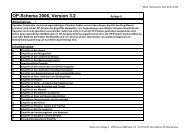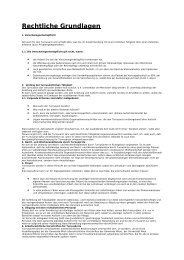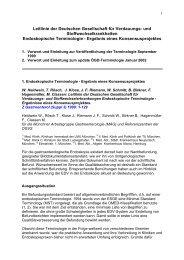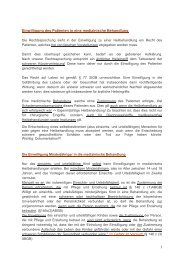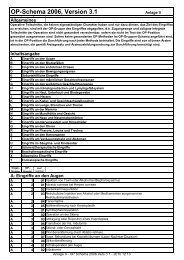ICD10 - Alphabetisch - Grafino.at
ICD10 - Alphabetisch - Grafino.at
ICD10 - Alphabetisch - Grafino.at
Sie wollen auch ein ePaper? Erhöhen Sie die Reichweite Ihrer Titel.
YUMPU macht aus Druck-PDFs automatisch weboptimierte ePaper, die Google liebt.
Hemihypästhesie KRANKHEITEN UND VERLETZUNGEN Hep<strong>at</strong>itis<br />
Hemihypästhesie R20.1<br />
Hemihypalgesie R20.8<br />
Hemihyperästhesie (Körperoberfläche)<br />
R20.3<br />
Hemihypertrophie, fazial Q67.4<br />
Hemikardie Q24.8<br />
Hemikranie<br />
– im Sinne von Migräne G43.9<br />
– kongenitale Fehlbildung Q00.0<br />
– paroxysmal, chronisch G44.0<br />
Hemimelie Q73.8<br />
– obere Gliedmaßen Q71.8<br />
– untere Gliedmaßen Q72.8<br />
Hemiparästhesie R20.2<br />
Hemiparalyse (s.a. Hemiplegia) G81.9<br />
Hemiparese (s.a. Hemiplegia) G81.9<br />
Hemiparkinson G20<br />
Hemiplegia, Hemiplegie G81.9<br />
– alternans facialis G83.8<br />
– aszendierend a.n.k. G81.9<br />
– – spinal G95.8<br />
– embolisch (aktuelles Ereignis) I63.4<br />
– hysterisch F44.4<br />
– infantil (postn<strong>at</strong>al) G80.2<br />
– kongenital (spastisch) (spinal) (zerebral)<br />
G80.2<br />
– Neugeborenes a.n.k. P91.8<br />
–– Geburtsverletzung P11.9<br />
– schlaff G81.0<br />
– spastisch G81.1<br />
–– infantil oder kongenital G80.2<br />
– thrombotisch (aktuelles Ereignis) I63.3<br />
Hemispasmus R25.2<br />
– facialis G51.3<br />
Hemisporose B48.8<br />
Hemitremor R25.1<br />
Hemizephalus, Hemizephalie Q00.0<br />
Hemmung der Lakt<strong>at</strong>ion O92.5<br />
Hepar lob<strong>at</strong>um (syphilitisch) A52.7†<br />
K77.0*<br />
Hep<strong>at</strong>algie K76.8<br />
Hep<strong>at</strong>is<strong>at</strong>ion, Lunge (akut)<br />
(s.a. Pneumonie, lobär) J18.1<br />
Hep<strong>at</strong>isch – s. Art der Krankheit<br />
Hep<strong>at</strong>itis (durch) (nach) K75.9<br />
– A – s. Hep<strong>at</strong>itis, Virus-, Typ A<br />
– akut a.n.k. K72.0<br />
–– mit Leberversagen (s.a. Versagen, Leber)<br />
K72.9<br />
– – alkoholisch K70.1<br />
– – infektiös B15.9<br />
––– mit Coma hep<strong>at</strong>icum B15.0<br />
– alkoholisch (akut) (chronisch) K70.1<br />
– Amöben (s.a. Abszeß, Leber, Amöben-)<br />
A06.4<br />
225<br />
– anikterisch, akut – s. Hep<strong>at</strong>itis, Virus-<br />
– Antigen-assoziiert (HAA) (s.a. Hep<strong>at</strong>itis,<br />
Virus-, Typ B) B16.9<br />
– Australia-Antigen (positiv) (s.a. Hep<strong>at</strong>itis,<br />
Virus-, Typ B) B16.9<br />
– autoimmun K75.4<br />
– B – s. Hep<strong>at</strong>itis, Virus-, Typ B<br />
– bösartig a.n.k. (mit Leberversagen) K72.9<br />
– C – s. Hep<strong>at</strong>itis, Virus-, Typ C<br />
– cholangiolitisch K75.8<br />
– cholest<strong>at</strong>isch K75.8<br />
– chronisch K73.9<br />
– – aktiv a.n.k. K73.2<br />
–– lobulär a.n.k. K73.1<br />
– – näher bez. a.n.k. K73.8<br />
– – persistierend a.n.k. K73.0<br />
– E – s. Hep<strong>at</strong>itis, Virus-, Typ E<br />
– Entamoeba histolytica (s.a. Abszeß, Leber,<br />
Amöben-) A06.4<br />
– epidemisch B15.9<br />
– – mit Coma hep<strong>at</strong>icum B15.0<br />
– Fetus oder Neugeborenes P59.2<br />
– fulminant a.n.k. (viral) – s. Hep<strong>at</strong>itis,<br />
Virus-<br />
– Gelbfieber- A95.9† K77.0*<br />
– granulom<strong>at</strong>ös a.n.k. K75.3<br />
– Herpesviren B00.8† K77.0*<br />
– homologe Serum- (s.a. Hep<strong>at</strong>itis, Virus-,<br />
Typ B) B16.9<br />
– Immunis<strong>at</strong>ion (s.a. Hep<strong>at</strong>itis, Virus-, Typ<br />
B) B16.9<br />
– infectiosa (acuta) (chronica) (subacuta)<br />
B15.9<br />
– – mit Coma hep<strong>at</strong>icum B15.0<br />
– Injektion, Inokul<strong>at</strong>ion oder Transfusion<br />
(Blut) (Plasma) (Serum) (andere Stoffe)<br />
(s.a. Hep<strong>at</strong>itis, Virus-, Typ B) B16.9<br />
– Inokul<strong>at</strong>ions- (s.a. Hep<strong>at</strong>itis, Virus-, Typ B)<br />
B16.9<br />
– interstitiell (chronisch) K74.6<br />
– k<strong>at</strong>arrhalisch (akut) B15.9<br />
– – mit Coma hep<strong>at</strong>icum B15.0<br />
– lupoid a.n.k. K73.2<br />
– Malaria B54† K77.0*<br />
– Mononukleose-, infektiös (Gammaherpesviren)<br />
B27.0† K77.0*<br />
– Mumps- B26.8† K77.0*<br />
– neon<strong>at</strong>al (toxisch) P59.2<br />
– reaktiv, unspezifisch K75.2<br />
– Serum- (s.a. Hep<strong>at</strong>itis, Virus-, Typ B)<br />
B16.9<br />
– syphilitisch (spät-) A52.7† K77.0*<br />
–– konn<strong>at</strong>al (früh-) A50.0† K77.0*<br />
––– spät- A50.5† K77.0*<br />
– – sekundär A51.4† K77.0*<br />
Hep<strong>at</strong>itis KRANKHEITEN UND VERLETZUNGEN Hernia<br />
Hep<strong>at</strong>itis (durch) (nach) (Forts.)<br />
– toxisch (s.a. Krankheit, Leber, toxisch)<br />
K71.6<br />
– Toxoplasmose (erworben) B58.1† K77.0*<br />
–– konn<strong>at</strong>al (aktiv) P37.1† K77.0*<br />
– tuberkulös A18.8† K77.0*<br />
– Virus- (akut) B19.9<br />
– – mit Coma hep<strong>at</strong>icum B19.0<br />
–– angeboren P35.3<br />
– – chronisch B18.9<br />
––– näher bez. a.n.k. B18.8<br />
––– Typ B B18.1<br />
–––– mit Delta-Virus B18.0<br />
––– Typ C B18.2<br />
– – Coxsackie- B33.8† K77.0*<br />
–– Komplik<strong>at</strong>ion bei Schwangerschaft, Entbindung<br />
oder Wochenbett O98.4<br />
–– näher bez. Typ a.n.k. (mit oder ohne<br />
Koma) B17.8<br />
–– Typ A B15.9<br />
––– mit Coma hep<strong>at</strong>icum B15.0<br />
– – Typ B B16.9<br />
––– mit<br />
–––– Coma hep<strong>at</strong>icum (ohne Delta-Virus-<br />
Begleitinfektion) B16.2<br />
–––– Delta-Virus (Begleitinfektion) (ohne<br />
Coma hep<strong>at</strong>icum) B16.1<br />
––––– mit Coma hep<strong>at</strong>icum B16.0<br />
– – Typ C B17.1<br />
–– Typ E B17.2<br />
–– Typ Non-A-Non-B B17.8<br />
–– Zytomegalie- B25.1† K77.0*<br />
– Zytomegalie- B25.1† K77.0*<br />
Hep<strong>at</strong>oblastom (M8970/3) C22.2<br />
Hep<strong>at</strong>ocholangiokarzinom (M8180/3)<br />
C22.0<br />
Hep<strong>at</strong>ocholangitis K75.8<br />
Hep<strong>at</strong>okarzinom (M8170/3) C22.0<br />
Hep<strong>at</strong>olentikuläre Degener<strong>at</strong>ion E83.0<br />
Hep<strong>at</strong>om (maligne) (M8170/3) C22.0<br />
– benigne (M8170/0) D13.4<br />
– embryonal (M8970/3) C22.0<br />
Hep<strong>at</strong>omegalia glycogenica diffusa E74.0†<br />
K77.8*<br />
Hep<strong>at</strong>omegalie (s.a. Hypertrophie, Leber)<br />
R16.0<br />
– mit Splenomegalie R16.2<br />
– bei infektiöser Mononukleose (Gammaherpesviren)<br />
B27.0† K77.0*<br />
– kongenital Q44.7<br />
Hep<strong>at</strong>onephromegalia glycogenica (von<br />
Gierke) E74.0<br />
Hep<strong>at</strong>op<strong>at</strong>hie K76.9<br />
Hep<strong>at</strong>optose K76.8<br />
226<br />
Hep<strong>at</strong>orenales Syndrom nach Wehen und<br />
Entbindung O90.4<br />
Hep<strong>at</strong>ose K76.8<br />
Hep<strong>at</strong>osplenomegalie R16.2<br />
– hyperlipämisch, Typ Bürger-Grütz E78.3†<br />
K77.8*<br />
Hep<strong>at</strong>ozystitis (s.a. Cholezystitis) K81.8<br />
Herausreißung, Auge S05.7<br />
Herbst – s. Art der Krankheit<br />
Herdenzephalitis (embolisch) (metast<strong>at</strong>isch)<br />
(s.a. Enzephalitis) G04.2<br />
Herdepilepsie (s.a. Epilepsia, fokal) G40.1<br />
Herdnephritis – s. Nephritis<br />
Herdparalyse, Lissauer- A52.1<br />
Herdpneumonie – s. Pneumonie, Broncho-<br />
Hereditär – s. Art der Krankheit<br />
Heredo<strong>at</strong>axie – s. Ataxia, hereditär<br />
Heredodegener<strong>at</strong>ion, makulär H35.5<br />
Heredop<strong>at</strong>hia <strong>at</strong>actica polyneuritiformis<br />
G60.1<br />
Heredosyphilis (s.a. Syphilis, konn<strong>at</strong>al)<br />
A50.9<br />
Hermaphroditismus (verus) Q56.0<br />
– 46,XX / 46,XY Q99.0<br />
– 46,XX mit Streak-Gonaden Q99.1<br />
– 46,XY mit Streak-Gonaden Q99.1<br />
– Chimäre 46,XX / 46,XY Q99.0<br />
Hernia, Hernie (erworben) (rezidivierend)<br />
K46.9<br />
– mit<br />
–– Einklemmung (s.a. Hernia, nach Lokalis<strong>at</strong>ion,<br />
mit, Einklemmung) K46.0<br />
– – Gangrän (s.a. Hernia, nach Lokalis<strong>at</strong>ion,<br />
mit, Gangrän) K46.1<br />
– abdominalis K46.9<br />
–– näher bez. Lokalis<strong>at</strong>ion a.n.k. K45.8<br />
––– mit<br />
–––– Einklemmung K45.0<br />
–––– Gangrän (und Einklemmung) K45.1<br />
– äußere – s. Hernia, inguinalis<br />
– Appendix – s. Hernia, abdominalis<br />
– Bandscheibe – s. Hernia, Nucleus pulposus<br />
– Bauchwand – s. Hernia, ventralis<br />
– cerebri (kongenital) (s.a. Enzephalozele)<br />
Q01.9<br />
– – endaural Q01.8<br />
– Cooper – s. Hernia, abdominalis, näher bez.<br />
Lokalis<strong>at</strong>ion a.n.k.<br />
– cordis Q24.8<br />
– corpus vitreum S05.2<br />
–– in die Vorderkammer H43.0<br />
– cruralis – s. Hernia, femoralis<br />
– Darmdivertikel – s. Hernia, abdominalis



